Preparation of Encapsulated Breakers for Polymer Gels and Evaluation of Their Properties
Abstract
:1. Introduction
2. Results and Discussion
2.1. Result Analysis
2.1.1. TEM Characterization of Capsule Core Emulsions and SEM Characterization of Encapsulated Breaker
2.1.2. IR Spectroscopy Analysis
2.1.3. TG Test and Analysis
2.2. Encapsulation Rate of Encapsulated Breaker
2.3. Electrical Conductivity of Encapsulated Breaker
2.4. Gel-Breaking Performance of Encapsulated Breaker
2.4.1. Effect of Temperature on Gel-Breaking Performance
2.4.2. Effect of Encapsulated Breaker Dose on Gel-Breaking Performance
2.4.3. Simulated Core Breakthrough Pressure Test
3. Conclusions
4. Materials and Methods
4.1. Instruments
4.2. Materials
4.3. Methods
4.3.1. Preparation of Encapsulated Breaker
- Preparation of UF prepolymer
- Preparation of SA capsule core emulsion
- Preparation of UF/SA encapsulated breaker
4.3.2. Test and Characterization
- Microstructure of the encapsulated breaker
- Determination of the encapsulation rate
- Electrical conductivity determination of the encapsulated breaker
4.3.3. Gel-Breaking Performance Test of the Encapsulated Breaker
Author Contributions
Funding
Institutional Review Board Statement
Informed Consent Statement
Data Availability Statement
Acknowledgments
Conflicts of Interest
References
- Bai, Y.; Liu, C.; Sun, J. High temperature resistant polymer gel as lost circulation material for fractured formation during drilling. Colloids Surf. A Physicochem. Eng. Asp. 2022, 637, 128244. [Google Scholar] [CrossRef]
- Yang, J.B.; Sun, J.S.; Bai, Y. Preparation and characterization of supramolecular gel suitable for fractured formations. Pet. Sci. 2023, 1, 11. [Google Scholar] [CrossRef]
- Bai, Y.; Zhang, Q.; Sun, J. Self-healing hydrogels and their action mechanism in oil–gas drilling and development engineering: A systematic review and prospect. J. Nat. Gas Sci. Eng. 2021, 96, 104250. [Google Scholar] [CrossRef]
- Fang, J.; Zhang, X.; Li, L. Research Progress of High-Temperature Resistant Functional Gel Materials and Their Application in Oil and Gas Drilling. Gels 2022, 9, 34. [Google Scholar] [CrossRef]
- Yang, J.; Bai, Y.; Sun, J. Experimental study on physicochemical properties of a shear thixotropic polymer gel for lost circulation control. Gels 2022, 8, 229. [Google Scholar] [CrossRef]
- Yang, J.; Sun, J.; Bai, Y. Review of the application of environmentally responsive gels in drilling and oil recovery engineering: Synthetic materials, mechanism, and application prospect. J. Pet. Sci. Eng. 2022, 215 Pt A, 110581. [Google Scholar] [CrossRef]
- Dubey, R. Microencapsulation technology and applications. Def. Sci. J. 2009, 59, 82. [Google Scholar]
- Ghasemi, H.; Darjani, S.; Mazloomi, H. Preparation of stable multiple emulsions using food-grade emulsifiers: Evaluating the effects of emulsifier concentration, W/O phase ratio, and emulsification process. SN Appl. Sci. 2020, 56, 2002. [Google Scholar] [CrossRef]
- Yang, J.; Sun, J.; Bai, Y.; Lv, K.; Zhang, G.; Li, Y. Status and Prospect of Drilling Fluid Loss and Lost Circulation Control Technology in Fractured Formation. Gels 2022, 8, 260. [Google Scholar] [CrossRef]
- Low, L.E.; Siva, S.P.; Ho, Y.K. Recent advances of characterization techniques for the formation, physical properties and stability of Pickering emulsion. Adv. Colloid Interface Sci. 2020, 277, 102117. [Google Scholar] [CrossRef]
- Reynaert, S.; Moldenaers, P.; Vermant, J. Control over colloidal aggregation in monolayers of latex particles at the oil-water interface. Langmuir 2006, 22, 4936–4945. [Google Scholar] [CrossRef]
- Doyle, C.D. Estimating thermal stability of experimental polymers by empirical thermogravimetric analysis. Anal. Chem. 1961, 33, 77–79. [Google Scholar] [CrossRef]
- Yang, Y.; Ning, Y.; Wang, C. Capsule clusters fabricated by polymerization based on capsule-in-water-in-oil Pickering emulsions. Polym. Chem. 2013, 4, 5407–5415. [Google Scholar] [CrossRef]
- Sheibat-Othman, N.; Bourgeat-Lami, E. Use of silica particles for the formation of organic-inorganic particles by surfactant-free emulsion polymerization. Langmuir 2009, 25, 10121–10133. [Google Scholar] [CrossRef] [PubMed]
- Niu, Z.; Yang, Z.; Hu, Z. Polyaniline–silica composite conductive capsules and hollow spheres. Adv. Funct. Mater. 2003, 13, 949–954. [Google Scholar] [CrossRef]
- Benson, G.A.; Spillane, W.J. Sulfamic acid and its N-substituted derivatives. Chem. Rev. 1980, 80, 151–186. [Google Scholar] [CrossRef]
- Zhou, H.; Wu, X.; Song, Z. A review of mechanism and adaptive materials of temporary plugging agent for chemical diverting fracturing. J. Pet. Sci. Eng. 2022, 212, 110256. [Google Scholar] [CrossRef]
- Hu, M.; Guo, J.; Yu, Y. Research advances of microencapsulation and its prospects in the petroleum industry. Materials 2017, 10, 369. [Google Scholar] [CrossRef]
- Pan, P.; Yan, X.; Peng, W. Tung Oil Microcapsules Prepared with Different Emulsifiers and Their Effects on the Properties of Coating Film. Coatings 2022, 12, 1166. [Google Scholar] [CrossRef]
- Shulkin, A.; Stöver, H.D.H. Polymer microcapsules by interfacial polyaddition between styrene–maleic anhydride copolymers and amines. J. Membr. Sci. 2002, 209, 421–432. [Google Scholar] [CrossRef]
- Pan, P.; Yan, X.; Wang, L. Effects of thermochromic fluorane microcapsules and self-repairing waterborne acrylic microcapsules on the properties of water-based coatings on basswood surface. Polymers 2022, 14, 2500. [Google Scholar] [CrossRef] [PubMed]
- Gulbis, J.; King, M.T.; Hawkins, G.W. Encapsulated breaker for aqueous polymeric fluids. SPE Prod. Eng. 1992, 7, 9–14. [Google Scholar] [CrossRef]
- Shu, B.; Yu, W.; Zhao, Y. Study on microencapsulation of lycopene by spray-drying. J. Food Eng. 2006, 76, 664–669. [Google Scholar] [CrossRef]
- Rodriguez, R.; Bekas, D.G.; Flórez, S. Development of self-contained microcapsules for optimised catalyst position in self-healing materials. Polymer 2020, 187, 122084. [Google Scholar] [CrossRef]
- Baymou, Y.; Bidi, H.; Touhami, M.E.; Allam, M.; Rkayae, M.; Belakhmima, R.A. Corrosion protection for cast iron in sulfamic acid solutions and studies of the cooperative effect between cationic surfactant and acid counterions. J. Bio-Tribo-Corros. 2018, 4, 1–17. [Google Scholar] [CrossRef]
- Bai, Y.; Zhu, Y.; Sun, J.; Shang, X.; Wang, J. High stability polymer gel for lost circulation control when drilling in fractured oil and gas formations, Geoenergy. Sci. Eng. 2023, 225, 211722. [Google Scholar]
- Chen, T.; Embree, H.D.; Brown, E.M. Enzyme-catalyzed gel formation of gelatin and chitosan: Potential for in situ applications. Biomaterials 2003, 24, 2831–2841. [Google Scholar] [CrossRef]
- Huang, B.; Zhang, W.; Zhou, Q. Preparation and experimental study of a low-initial-viscosity gel plugging agent. ACS Omega 2020, 5, 15715–15727. [Google Scholar] [CrossRef]
- Qinfeng, D.I.; Zhang, J.; Shuai, H.U.A. Visualization experiments on polymer-weak gel profile control and displacement by NMR technique. Pet. Explor. Dev. 2017, 44, 294–298. [Google Scholar]
- Jiang, G.; Deng, Z.; He, Y. Cross-linked polyacrylamide gel as loss circulation materials for combating lost circulation in high temperature well drilling operation. J. Pet. Sci. Eng. 2019, 181, 106250. [Google Scholar] [CrossRef]


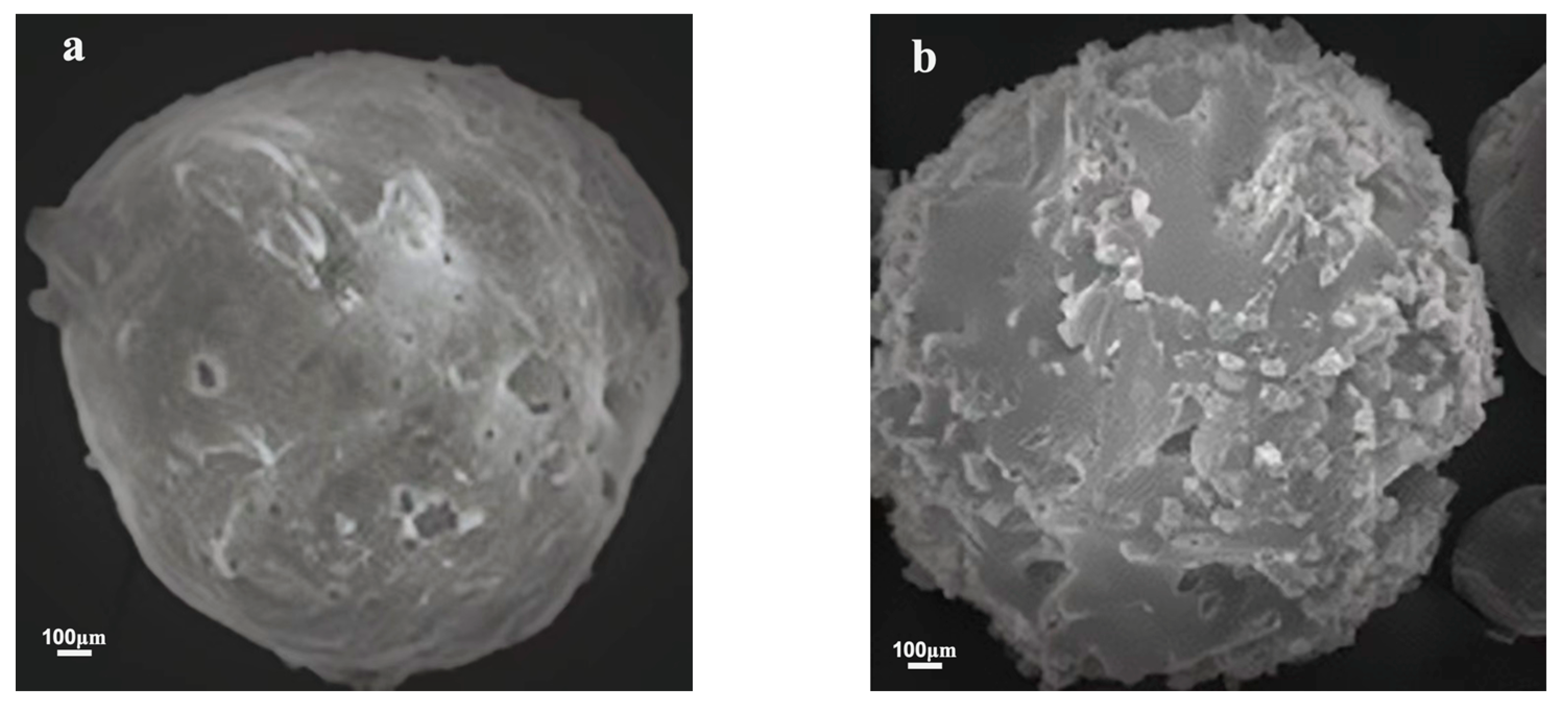
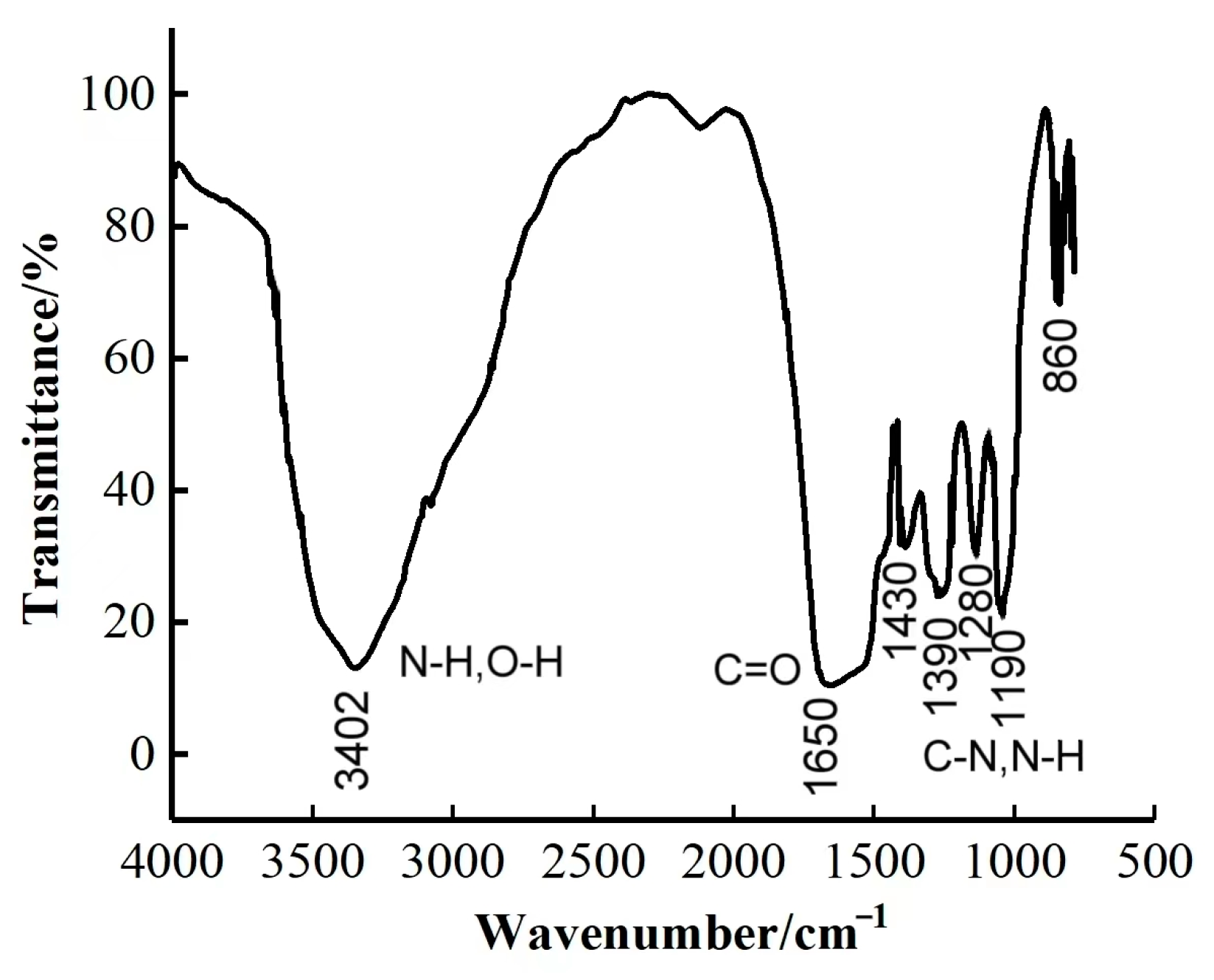
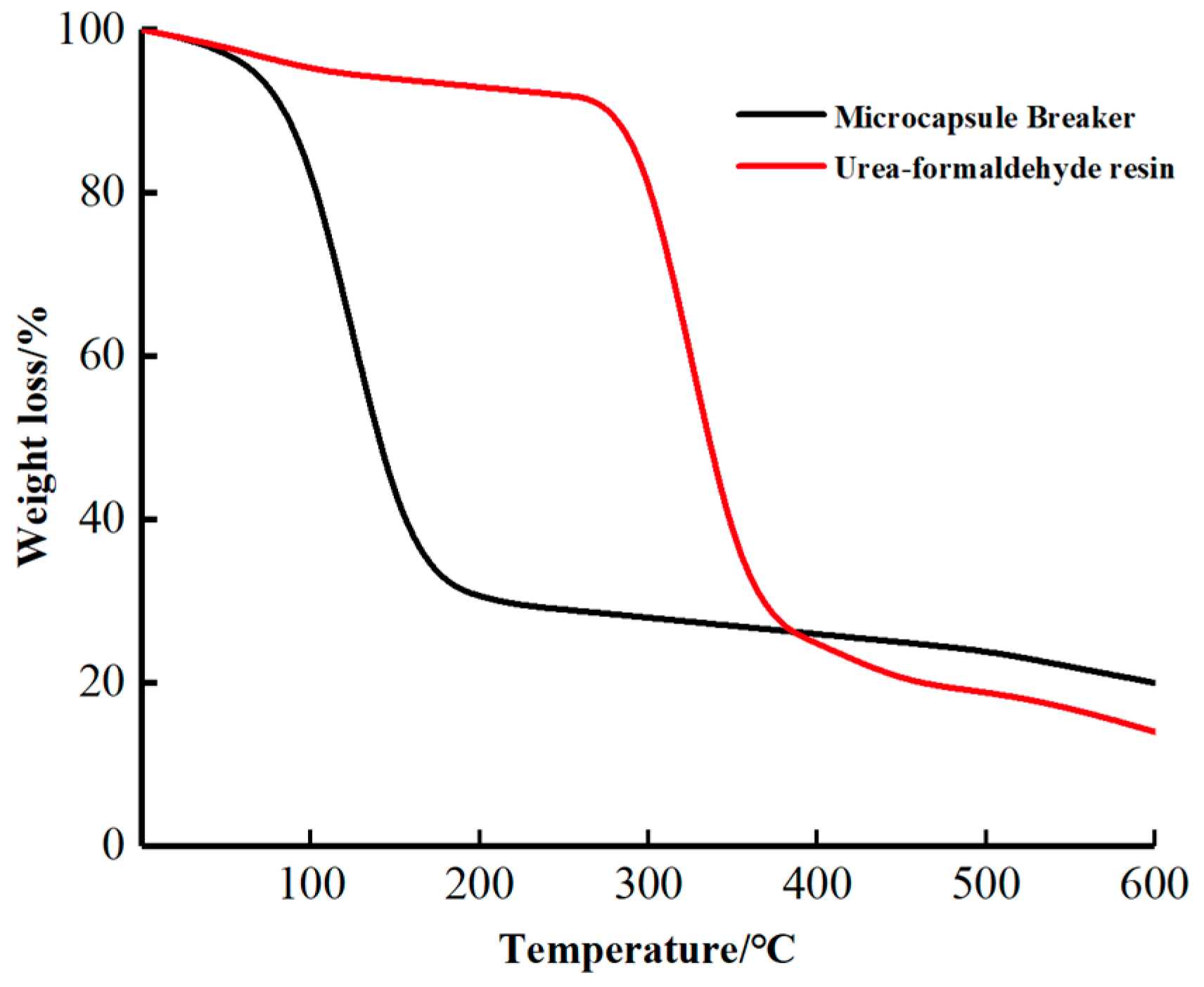
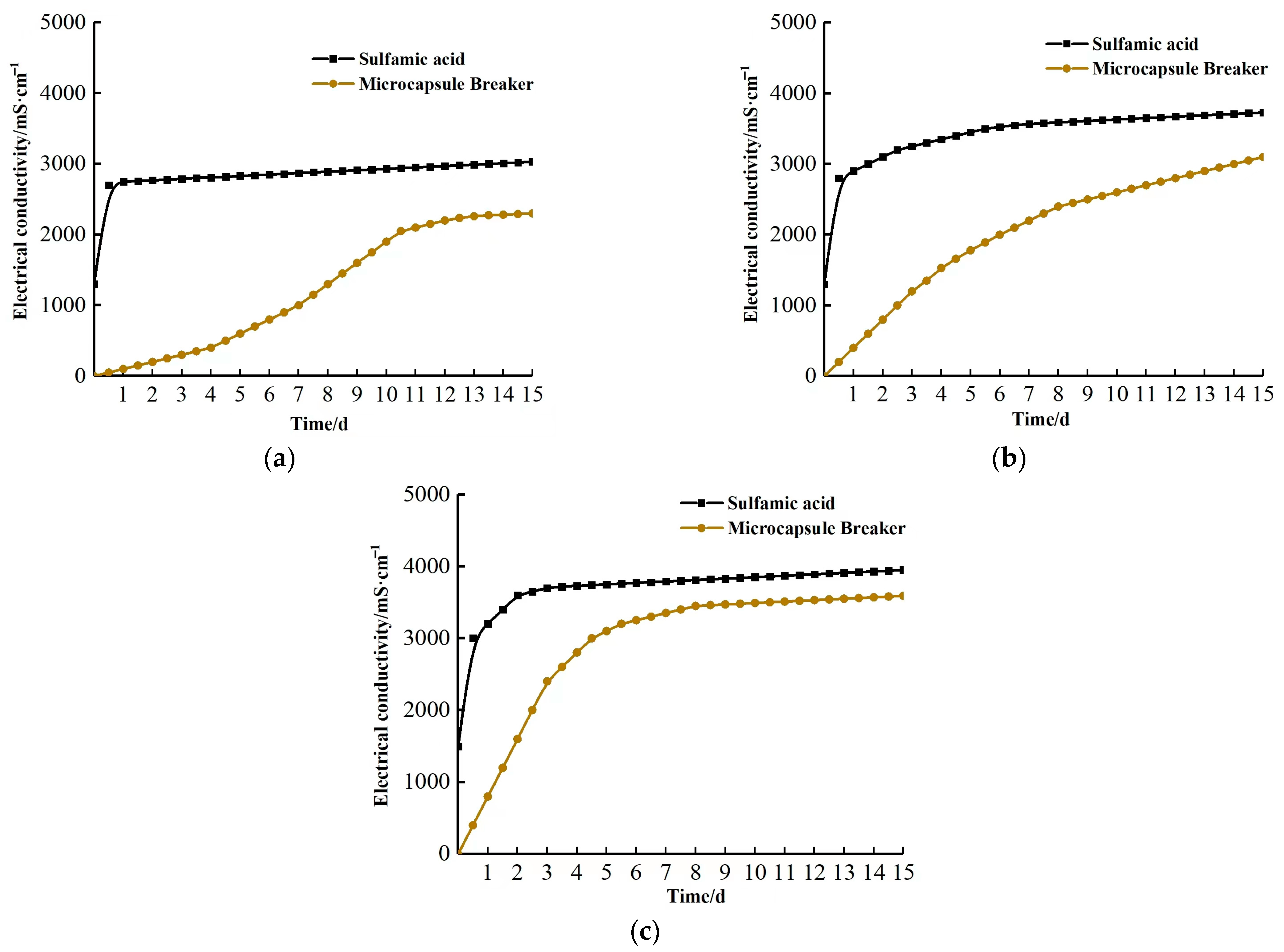
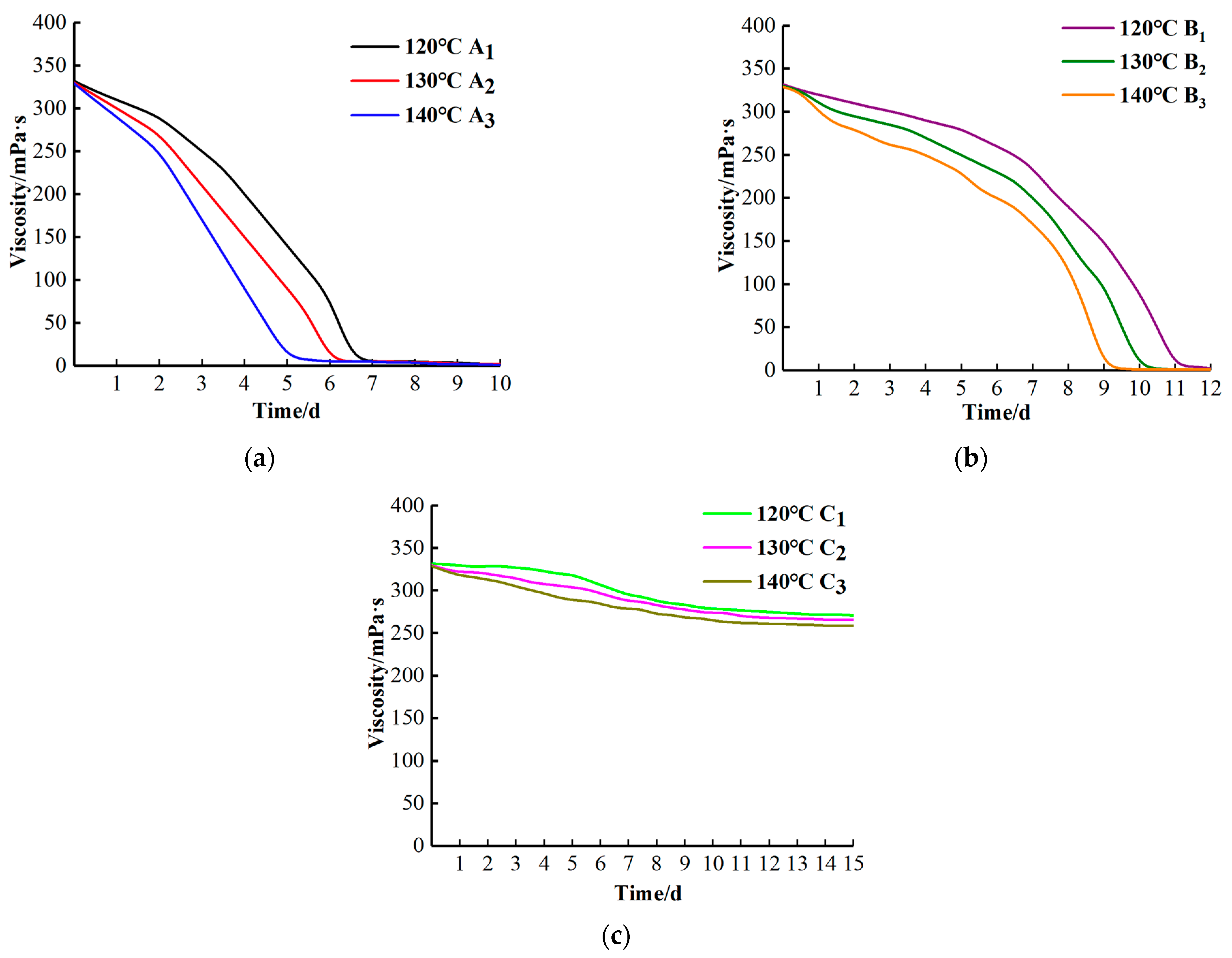


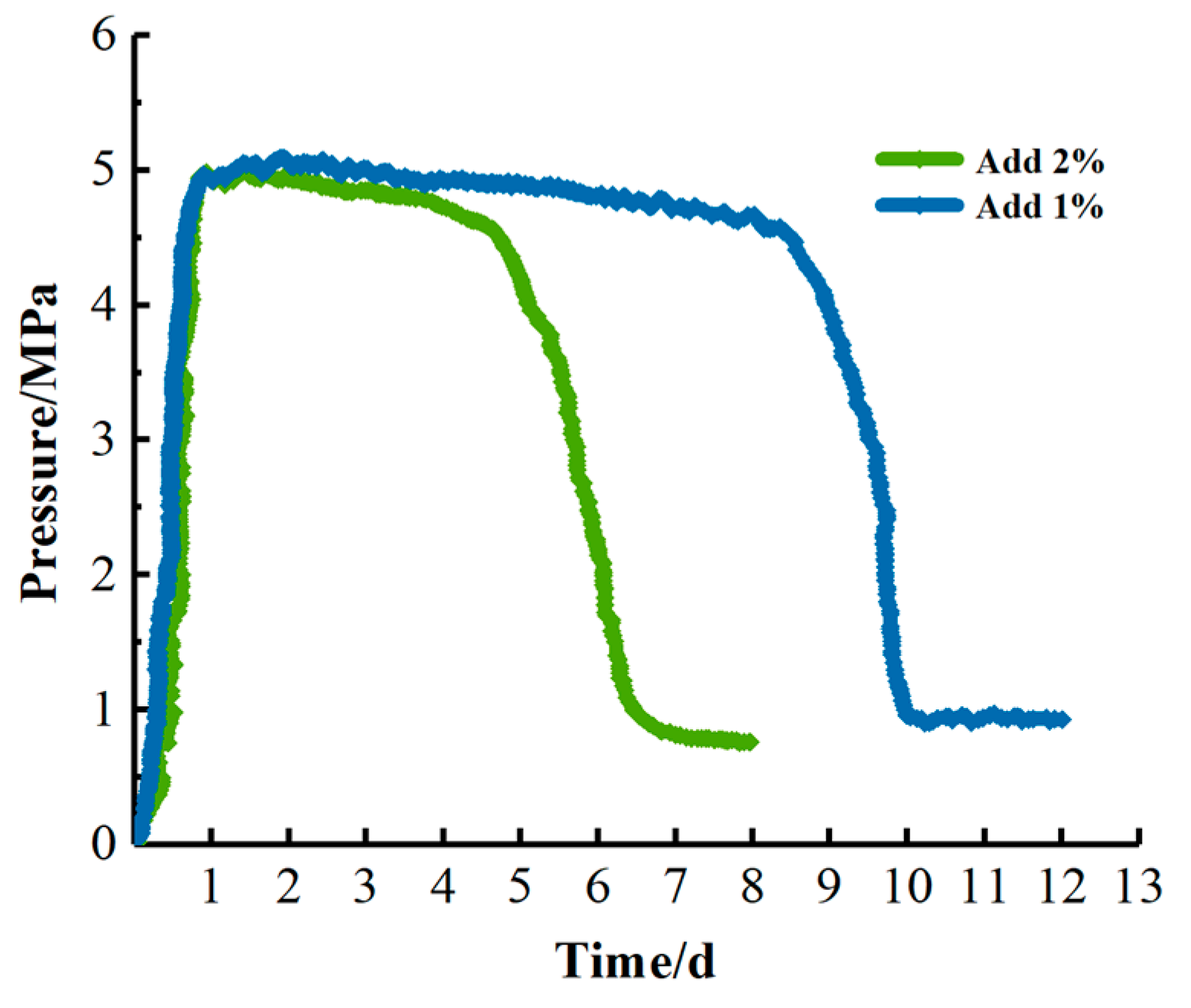

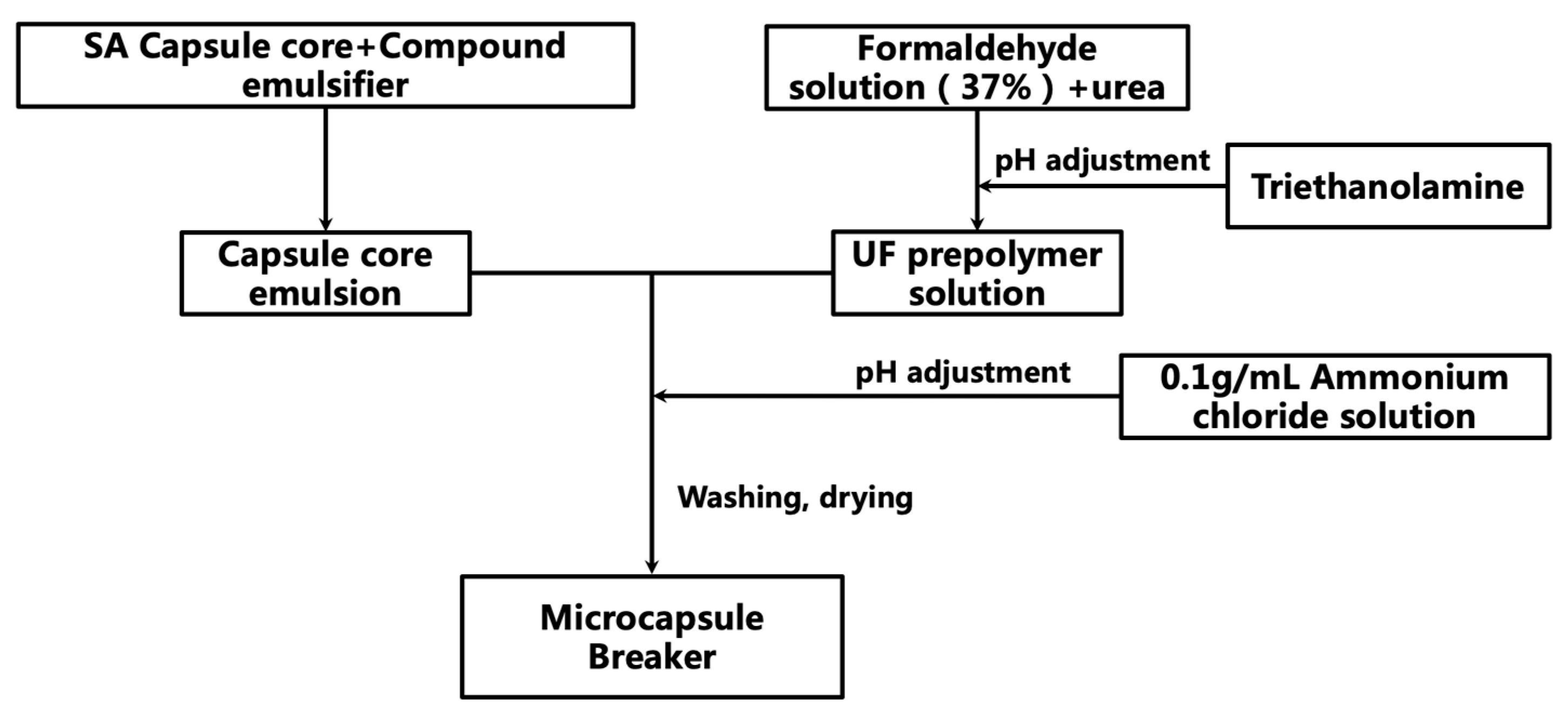
| Group | Molar Ratio (nurea:nformaldehyde) | Emulsifier | Encapsulation Rate/% |
|---|---|---|---|
| 1 | 1:1.7 | Span 80 | 68.32 |
| 2 | 1:1.7 | SDBS | 70.64 |
| 3 | 1:1.7 | Span 80/SDBS | 79.47 |
| 4 | 1:1.8 | Span 80 | 74.38 |
| 5 | 1:1.8 | SDBS | 77.52 |
| 6 | 1:1.8 | Span 80/SDBS | 85.86 |
Disclaimer/Publisher’s Note: The statements, opinions and data contained in all publications are solely those of the individual author(s) and contributor(s) and not of MDPI and/or the editor(s). MDPI and/or the editor(s) disclaim responsibility for any injury to people or property resulting from any ideas, methods, instructions or products referred to in the content. |
© 2023 by the authors. Licensee MDPI, Basel, Switzerland. This article is an open access article distributed under the terms and conditions of the Creative Commons Attribution (CC BY) license (https://creativecommons.org/licenses/by/4.0/).
Share and Cite
Lv, K.; Zhang, G.; Bai, Y.; Yang, J. Preparation of Encapsulated Breakers for Polymer Gels and Evaluation of Their Properties. Gels 2023, 9, 387. https://doi.org/10.3390/gels9050387
Lv K, Zhang G, Bai Y, Yang J. Preparation of Encapsulated Breakers for Polymer Gels and Evaluation of Their Properties. Gels. 2023; 9(5):387. https://doi.org/10.3390/gels9050387
Chicago/Turabian StyleLv, Kaihe, Guodong Zhang, Yingrui Bai, and Jingbin Yang. 2023. "Preparation of Encapsulated Breakers for Polymer Gels and Evaluation of Their Properties" Gels 9, no. 5: 387. https://doi.org/10.3390/gels9050387
APA StyleLv, K., Zhang, G., Bai, Y., & Yang, J. (2023). Preparation of Encapsulated Breakers for Polymer Gels and Evaluation of Their Properties. Gels, 9(5), 387. https://doi.org/10.3390/gels9050387







